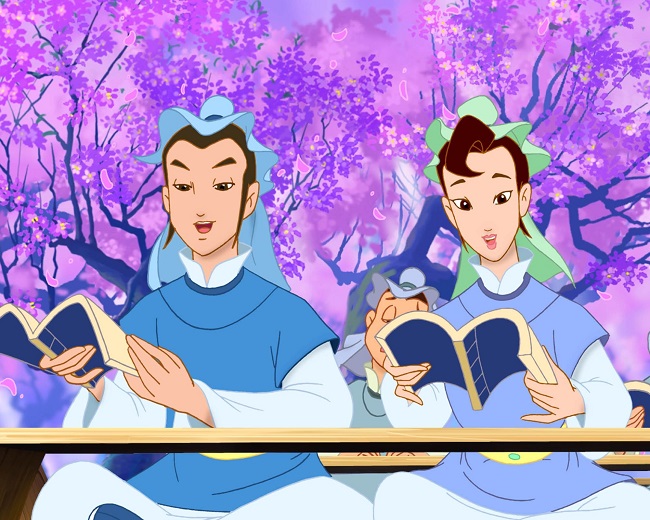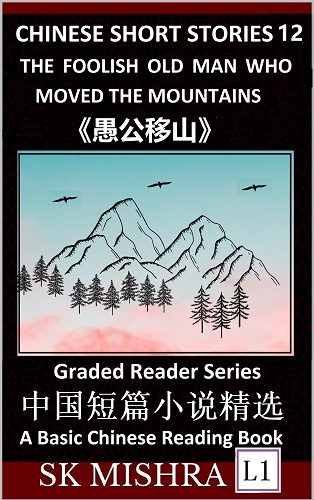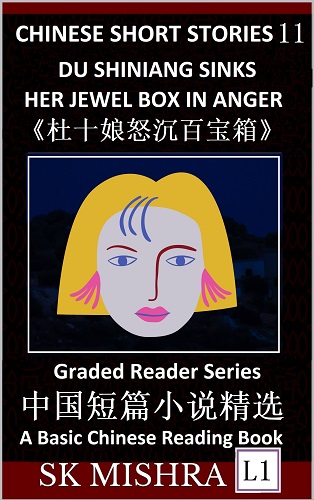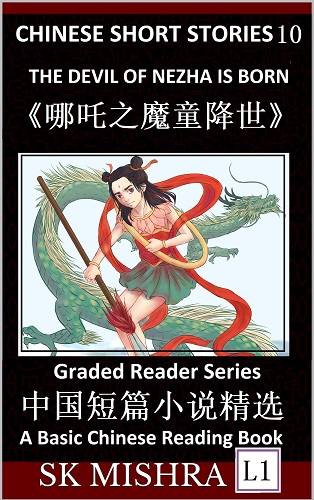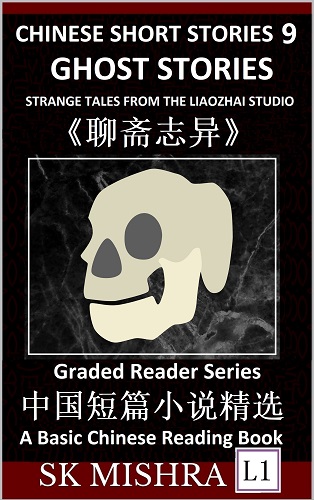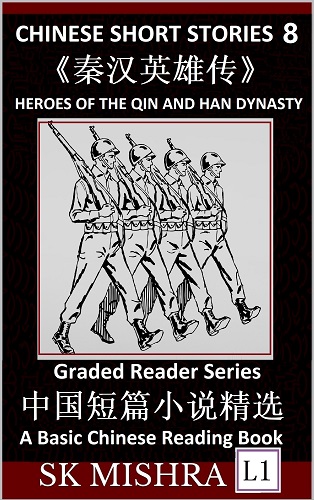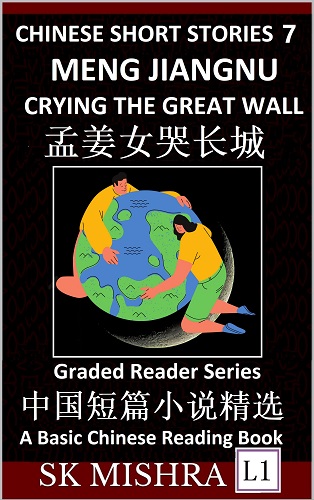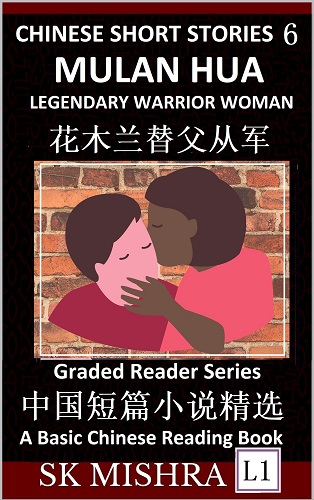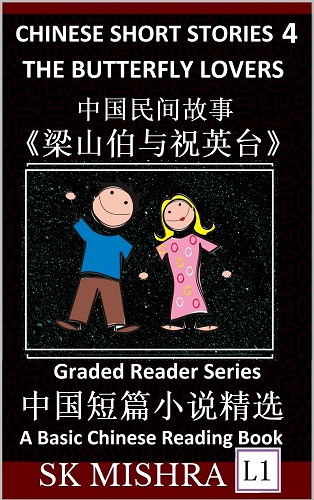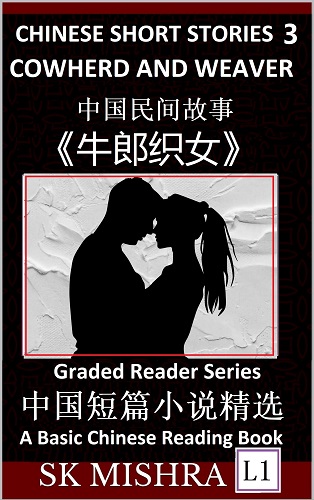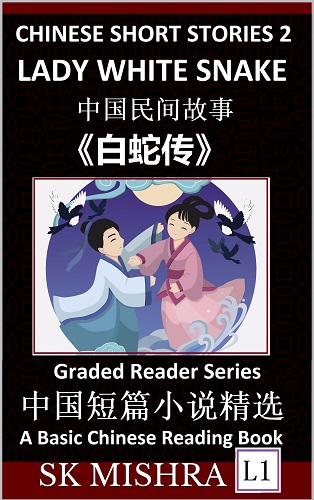Learning a complex language like Mandarin Chinese has never been an easy task. However, the whole learning process could be very interesting if you discover fun ways of going through this long and time-consuming journey. In this blog-post, I’ll be recommending you a list books to learn traditional Chinese stories. These books are suitable for the beginners (Level 1/2) as they are made of 500+ simplified characters (pinyin is as well included). All the stories are very popular in China and everyone, here in China, knows about them. So, if you are into digging the ancient Chinese language and culture, learning these stories are indispensable for your Chinese endeavors.
Kindle (eBook version) and Paperback (2nd edition):

Chinese Short Stories 1: Epic Fairy Tales, Folklores, Fables, Mythology & Legends.
In fact, the natives feel that the Chinese folktales are quite chaotic as there are excessively many tales and legends, and then, there are many different versions of the same stories. Quite a few of these stories are connected to each other. Generally, when Chinese people talk to each other about these traditional stories, they’d often hold their own opinions and argue endlessly. Well, it can only be said that the Chinese cultural heritage is simply too deep. However, in order to better understand and study Chinese culture, you’ll need to have at least a general idea of these fictional stories.
As a gentle reminder, if you are totally a beginner, no offence, you are strongly recommended to begin with learning those mysterious Chinese characters at the earliest:
Once you have gone through a few of hundred characters, understand Mandarin radicals and feel comfortable with character structures, start doing reading practice ASAP. The more reading you do, the better you’ll be able to remember/understand Chinese characters and sentences.
Learn Chinese Language and Culture
Moreover, as you go through beautiful Mandarin Chinese journey, make sure you are confident with the initial level books:
- Level 1: Chinese Reading Books (Chinese Elementary/Primary School Education Series)
- Level 1: Chinese Reading Books (Chinese Short Story Series, 500+ characters)
- Level 1: Chinese Reading Books (Journey to the West Series, 600 characters)
- Level 2: Chinese Reading Books (Biographies of China’s Famous Personalities, 600 characters)
- Level 2: Chinese Reading Books (Chinese Reading Comprehension, 600+ characters)
- Level 2: Chinese Reading Books (Chinese History Series, 900 characters)
- Level 3: Chinese Reading Books (Chinese Culture Series, 1000 characters)
- Level 4 & 5: Chinese Reading Books (Chinese Geography and Economy Series, over 1000 characters)
- Level 6: Chinese Reading Books (Chinese Classical Literature Masterpieces, about 1300 characters)
Now it’s time to do Chinese reading practice with Level 4 books!
Level 1: Chinese Short Story Series Reading Books with Pinyin
Here is the list of books to learn Chinese stories (Mandarin reading practice book series). You may also want to check out the author’s home page.
Chinese Short Stories 12: The Foolish Old Man Who Moved the Mountains
Yugong Yishan (愚公移山) is a fable essay created by the Chinese philosopher Liezi (列子, 450 AD–375 AD) during the Warring States Period (战国时期). The Warring States period was an era of great social change, as well as a period of controversy among academic scholars. As an important part of Zhuzi’s prose (诸子散文), the fable was a powerful weapon for the Warring States to clarify their political views and academic thoughts. The fable narrates the story of an old man named Yugong, who is almost 90 years old, and lives directly opposite the mountain. Suffering from the obstruction in the northern part of the mountainous area, he tried to dig up the steep mountain to make a road leading to the southern part. When the mountain god (山神) learnt about Yugong’s resolve, he was afraid that Yugong would dig the mountain endlessly. Therefore, the mountain god reported his concerns to the Emperor of Heaven (天帝). However, the Emperor was moved by Yugong’s sincerity, hardship, and perseverance. Subsequently, the Emperor ordered the obstructive mountains to be removed. From this time, there was no high mountain barrier for Yugong.
- Paperback (ISBN 9798887341095): Amazon
- Paperback (ISBN 9798887341095): Barnes & Noble
Chinese Short Stories 11: Du Shiniang Sinks Her Jewel Box in Anger
Du Shiniang Sinks Her Jewel Box in Anger (杜十娘怒沉百宝箱), originally written by Feng Menglong (冯梦龙, 1574-1646, a Ming Dynasty writer, thinkers, and opera artist), is one of the most outstanding short stories in the history of ancient Chinese literature, and its ideological content and artistic achievements occupy the peak of ancient Chinese short stories. The story, with its delicate brushstrokes, portrays Du Shiniang (杜十娘), a female figure, who is persistently pursuing the good wishes in her own heart, and has achieved extraordinary and outstanding artistic milestones. Du Shiniang, a famous prostitute in Beijing, pursued true love in order to redeem her life, and entrusted her life to Li Jiasheng (李甲生), a college student and the rich son of Shaoxing (绍兴). However, Li Jiasheng was weak and selfish. Although he was truly in love with Du Shiniang, he succumbed to the social and family ethics. No matter how hard Du Shiniang tried, she couldn’t escape the shackles of her tragic fate. Li Jia turned her back on her faith and eventually, coupled with Sun Fu’s (孙富) instigation, he eventually sold Du Shiniang. Under all disillusionment, Du Shiniang scolded Sun Fu, scolded Li Jiasheng, and threw a jewel box, treasured for many years, into the river, and finally jumped in the rolling waves.
- Paperback (ISBN 9798887341088): Amazon
- Paperback (ISBN 9798887341088): Barnes & Noble
Chinese Short Stories 10: The Devil of Nezha is Born
“The Devil of Nezha is Born” (哪咤传奇之魔童降世) is a famous folktale adapted from the Chinese mythology and tells the story of Nezha’s growing experience of “being born to be a devil” but “fighting against the sky to the end”. Nezha (哪咤) is the reincarnation of Mo Wan (魔丸), son of Li Jing (李靖). Because of his reincarnation status, he faced discrimination, exclusion, ridicule, and hostility by the people of Chen Tangguan (陈塘关). As a result, he felt lonely, indifferent, rebellious, stubborn, cynical, and he created trouble for the people of Chen Tangguan, so that no one could live peacefully. Under the cynical appearance, Nezha is more lonely than anyone else is, and he is constantly eager for social approval. As such, Nezha was supposed to be a hero. However, he became the great demon king of the world.
- Paperback (ISBN 9798887341071): Amazon
- Paperback (ISBN 9798887341071): Barnes & Noble
Chinese Short Stories 9: Ghost Stories, Strange Tales from the Liaozhai Studio
Ghost Stories, Strange Tales from the Liaozhai Studio (聊斋志异, Liao Zhai Zhi Yi), is a collection of classical Chinese short stories inspired by the work of Pu Songling (蒲松龄), a renowned Qing Dynasty (清朝) novelist. These stories expose the darkness of feudal society, attack the decay of the imperial examination system and resist the shackles of feudal ethics and education. The original work of Pu Songling contains total 491 (divided into 24 volumes) short stories and have rich and profound ideological content of Chinese culture. The stories often depict the theme of love. Some of these tales express ideal romance and love between supernatural ghosts and human beings.
- Paperback (ISBN 9798887341064): Amazon
- Paperback (ISBN 9798887341064): Barnes & Noble
Chinese Short Stories 8: Heroes of the Qin and Han Dynasty
Heroes of the Qin and Han Dynasty (秦汉英雄传), also known as the Legend of Overlord-Heroes of the Qin and Han Dynasty (霸王传——秦汉英雄), is based on the magnificent history of the late Qin and Han Dynasties. The story revolves around the lives of a large number of Chinese historical figures such as Zhang Liang (张良), Liu Bang (刘邦), Xiang Yu (项羽), Qin Shihuang (秦始皇), Li Si (李斯), Zhao Gao (赵高), Yan Le (阎乐), etc. The plot is in line with history, for example, after Qin unified China, Zhang Liang, who was dissatisfied with the rule of the Qin dynasty, planned to assassinate Qin Shihuang, the founder of the Qin Dynasty (秦朝) and the First Emperor of a unified China (统一中国的第一位皇帝). However, Zhang Liang’s premeditated plans were leaked to the government. Subsequently, Zhang Liang was raided by the government officials. However, Zhang Liang was able to escape, and a lot happened afterwards.
- Paperback (ISBN 9798887341057): Amazon
- Paperback (ISBN 9798887341057): Barnes & Noble
Chinese Short Stories 7: Meng Jiangnu Crying the Great Wall
The story of Meng Jiangnu (孟姜女的传说), as one of the four love legends in ancient China (the other three are the Cowherd and the Weaver, Liang Shanbo and Zhu Yingtai, and the Biography of the White Snake), has been widely circulated orally (口头传承) for thousands of years through. The story originates from the historical facts of Qiliang’s Wife Crying Husband (杞梁妻哭夫). There are two protagonists in the story, one is Meng Jiang (孟姜女) and the other is Qiliang (杞梁). The legend of Meng Jiangnu has a very early origin, and it has existed since the Warring States (战国, 475–221 BCE) period. In 2006, the legend of Meng Jiangnu was included in the first batch of national intangible cultural heritage lists by the State Council (国务院), China’s State Department.
- Paperback (ISBN 9798887341040): Amazon
- Paperback (ISBN 9798887341040): Barnes & Noble
Chinese Short Stories 6: Mulan Hua, China’s Legendary Warrior Woman
Mulan Hua (花木兰) is a legendary female warrior of ancient Chinese literature. She is also a legendary figure of the Northern and Southern Dynasties (南北宋, 386–589 CE). Her story is a tragic heroic epic. Mulan first appeared in a narrative poem Ballad of Mulan (木兰诗) in the Northern and Southern Dynasties. The ancient Chinese warrior believed in filial piety, and her surrogate army defeated the invading people. She is the first known person of Chinese legends, capable of Dragon Miraculous, the supernatural abilities to transform oneself into an animal-themed superhuman. The emperor of the Tang Dynasty (唐朝, 618–907 CE) called her General Xiaolie (孝烈将军). To date, her story has been passed down through the ages. Although the spread of the Mulan story should be attributed to the folk poem “Mulan”, Mulan Hua’s identiry and birthplace are not confirmed in the history books. Nevertheless, Mulan’s deeds are represented by a variety of literary and artistic works, such as movies, TV dramas, and operas.
- Paperback (ISBN 9798887341033): Amazon
- Paperback (ISBN 9798887341033): Barnes & Noble
Chinese Short Stories 5: Lady Chang E Flying to the Moon
The story of Lady Chang É Flying to the Moon (嫦娥奔月) originated from the worship of the stars by the ancient Chinese. In fact, the myths and legends from ancient times in China tell the story of Chang E (嫦娥) being forced by Fengmeng (逢蒙). According to the existing written records, it first appeared in ancient books such as Huainanzi (《淮南子》) in the in the Western Han Dynasty (西汉). Helplessly, after eating an immortal medicine given to her husband Houyi (后羿) by the Queen Mother of the West (西王母), Chang E flew to the Moon Palace. According to Huainanzi, Chang E fled because she stole the medicine that her husband Houyi took from the West Queen Mother, and flew into the Moon Palace, turning into a poisoned toad.
- Paperback (ISBN 9798887341026): Amazon
- Paperback (ISBN 9798887341026): Barnes & Noble

Chinese Short Stories 4: Butterfly Lovers, Tragic Love of Liang Shanbo and Zhu Yingtai
The Butterfly Lovers is a very famous Chinese folktale of the tragic love between Liang Shanbo and Zhu Yingtai. The Liang Zhu legend and love story include certain real events that have happened in history as they are supported by historical data and cultural relics. Since the Eastern Jin Dynasty (东晋, 317年-420年), the folktale has already been circulated for more than 1,700 years. In Chinese culture, the story is often described as an eternal song of love. In fact, the folk story is one of the four major love stories of ancient Chinese folk (the remaining three are: The White Snake, The Legend of Meng Jiangnv, and The Cowherd and the Weaver). The current book volume, Chinese Short Stories 4, is a Level 1 Chinese reading practice book. It would introduce you to the famous Chinese folk story of the Butterfly Lovers 《梁山伯与祝英台》.
- Paperback (ISBN 9798887340968): Amazon
- Paperback (ISBN 9798887340968): Barnes & Noble
Chinese Short Stories 3: Cowherd and Weaver
The Legend of Cowherd is a famous ancient Chinese Han folk love story, and also one of China’s four classic folklore stories. It is the earliest story of the Chinese people about the stars. The story of the Cowherd and Girl Weaver, which contains romance in the classics, also reflects the precious twists and turns of love. The current book volume, Chinese Short Stories 3, is a Level 1 Chinese reading practice book. It would introduce you to the famous Chinese folk story of Cowherd and Weaver (《牛郎织女》).
- Paperback (ISBN 9798887340821): Amazon
- Paperback (ISBN 9798887340821): Barnes & Noble
Chinese Short Stories 2: Lady White Snake
The Legend of the White Snake has a long history and is one of the four major folk love legends in China. The story matured and flourished in the Qing Dynasty and is a model of Chinese folk collective creation. It describes a twisted love story between an adult snake spirit and a human. The current book volume, Chinese Short Stories 2, is a Level 1 Chinese reading practice book. It would introduce you to the famous Chinese folk story of the Lady White Snake (《白蛇传》).
- Paperback (ISBN 9798887340791): Amazon
- Paperback (ISBN 9798887340791): Barnes & Noble
Chinese Short Stories 1: 8 Short Stories
Chinese fairy tales are very important part of China’s rich folk literature. These fairy tales and fables are extremely rich cultural heritage and precious moral wealth created by the Chinese ancestors for thousands of years and have been verbally circulated since ancient times. They carry emotions, moral traditions, personality characteristics, myths, cohesion and affinity. The supernatural tales often tell various relationships between human and nature in the form of bizarre language and symbols. Their themes are usually broad and include fantasy narrative stories. Folktales are certainly not limited to the actual real-life situations and what would people think as true and reasonable. Rather, they often contain natural and whimsical ingredients. Understanding these stories are indispensable for learning Chinese culture and to gain a better knowledge of Mandarin Chinese language.
- Paperback (ISBN 9798887340784): Amazon
- Paperback (ISBN 9798887340784): Barnes & Noble

I will regularly update the list, so do stop by, at least once in a while!
To sum up, Mandarin Chinese is arguably one of the most difficult languages to learn. However, if you learn smartly, you can indeed learn Chinese much faster. Although the road to learning Chinese is certainly not an easy one, it’s absolutely worth it!
Once you have done enough reading practices, you will be able to read any random piece of Chinese manuscript.
That’s all in this post about How to Learn Chinese Culture by Reading Practice Books. If you have any question about learning Mandarin Chinese, traveling, living or working in China, do let me know in the comments! Feel free to post in our forum so that others could also contribute and learn. For regular updates like us on Facebook, or follow on Twitter!
If you find the write-ups useful, don’t forget to buy me a beer!
Wish you a great time learning Mandarin Chinese!
Cheers!
Last updated: Friday, December 16, 2022
